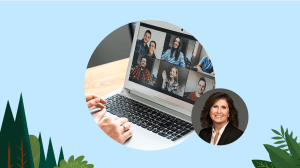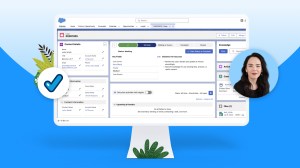Quick Take: This is the second installment in a Newsroom series focused on helping CIOs navigate a digital-first world and adapt to new working models. The series brings together a variety of respected industry voices to share their insights, opinions, and commentary.
Chief Information Officers (CIOs) are constantly looking for ways to improve the employee experience. Why? Because when IT teams offer the best technology, employees can focus on what makes them exceptional — like building new products, helping customers be successful, and growing the business.
Effective technology also leads directly to improved employee retention. New research shows that employees dissatisfied with their work technology are more than twice as likely to leave their job in the next year than those who are satisfied.
The simple truth is everyone wants to feel productive while they’re at work. When we get bogged down in cumbersome technology — jumping back and forth between different applications, typing out redundant sign-ons, wading through manual processes running on legacy equipment — it becomes impossible to thrive.
At Salesforce we hire top talent, and a big part of my job is providing our talent with the right tools to tap into their intellect and free them from mundane tasks. This includes giving our employees the tools they need to be productive from anywhere. As we move further towards an all-digital world, our employees spend more and more of their days on the devices, apps, and services that my team offers, and they expect that technology to help them, not hinder them.
They want the experience to be intuitive and easy, and we don’t take that responsibility lightly.
In today’s environment, great CIOs need to unlock new ways to work smarter than ever. While we still supply standard back office and tech support, we now also design platforms to attract top performers, onboard them, provide service and support, and drive engagement throughout the employee lifecycle. Technology should enable us to be the best versions of ourselves. We optimize productivity by ridding the workplace of what I call “energy wasters” and focus on building technology that is so easy to use it fades into the background.
The CIO position isn’t a left brain or right brain job any longer — it’s both at the same time, all the time.
I know I’m not the only CIO thinking about how I can help my organization work smarter. I’ve asked a few of my fellow IT leaders to offer their thoughts on what the future of the employee experience will look like, and how IT can help unlock the workforce’s full potential.
Q. What kind of impact can a CIO have on employee experience?
“Helping build an organization’s data culture should be top of mind for CIOs. A data culture helps employees gain the data skills they need to be successful by empowering people to make faster, better decisions. Organizations with people who are confident using data are often more creative and innovative, too. Data and analytics will continue to drive profound change and transformation in business, and CIOs and other leaders are at the heart of that.” Andrew Beers, CTO, Tableau
“These days, with everyone working from home and across different cities and time zones, it’s difficult to listen to everyone and create company-wide alignment. But modern CIOs can collect continuous feedback from all employees and help companies react in real time. My team is constantly looking at employee feedback to hear what’s working, what’s not, and what could become an issue if it is not addressed. That’s a big leap forward.” Federico Larsen, CTO, Copado
“CIOs enable a consistent and seure experience for employees who have been under a lot of pressure at work during lockdown. Those tools need to be practical and cost effective without becoming too complicated or insecure. This year has taught us that they can also be fairly simple. A good suite of apps for spreadsheets, word processing, and video conferences often does the trick. But the biggest step we can take is giving users a seamless experience, a collaborative experience, delivering easy access to the information they need by reducing friction with an intuitive design.” Craig Walker, SVP, Strategic Customer Advisor (former CIO, Shell)
“The greatest impact we can have is ensuring employees around the globe have a safe, reliable and connected experience within day-to-day operations. Discipline in driving process excellence and consistency ensures employees have the right tools and appropriate access to do their job. This begins with world-class, employee-facing and concierge-like helpdesk support all the way through to technology decisions around infrastructure, applications, and tools.” Leo Minervini, CIO, OwnBackup
Q. Are you seeing an increased focus on employee experience lately? What new responsibilities have IT departments taken on to support this?
“Absolutely, and I think this goes back to the fact that our expectations have changed. Almost everything we do in our personal life involves a mobile phone, and more and more we expect the same from work. That puts the burden on the IT organization to create an environment where employees can do their work with best-in-class tools and applications. Creating unity through an integrated single-sign-on platform is such a simple sounding idea, but traditionally it has been difficult to achieve with older generations of technology. It’s very doable now and it’s good for security, productivity and morale.” Casey Coleman, SVP of Global Government Solutions, Salesforce (former CIO, GSA)
“IT is taking on a leadership role in democratizing innovation by starting to turn every asset — every piece of data, process and application — into reusable building blocks that form the foundation for composability. With the shift to remote, organizations asked IT on average to deliver on 30% more projects over the last 12 months according to the recent Connectivity Benchmark Report. The same report finds only 37% of IT teams were able to complete all the projects asked of them last year. For an organization to scale faster, employees need to be empowered to imagine, assemble and deliver their own innovations. One of the key responsibilities for IT teams is to not only create this foundation of composability, but also educate and enable their business counterparts to self-serve and unlock data to make innovation happen at scale securely.” Brent Hayward, CEO, MuleSoft
“We have absolutely seen an increased focus on the employee experience. The pandemic has made us focus on what we can control and the technology that is available to our workforce. We have invested heavily in what we believe are the best technology solutions for our team — whether remote or in an office. As for new responsibilities, making technology accessible in a safe and controlled manner is top of mind. For example, there is less touch in and around conference rooms in how to begin and end a meeting, and even low touch door access capabilities while maintaining a secure physical office space.” Leo Minervini, CIO, OwnBackup
“I’m seeing a lot of innovation in how we train employees in the digital world. The easier, more remote and gamified the tools are, the less training employees will need. If you want to skill employees up on the latest safety information, company narrative, customer service guidance, or just something fun, the best way to do it is through remote trackable training. If it’s available on a mobile device and it’s gamified, employees will get a thrill out of doing it given that it’s easy to access – even better if they can track their progress against peers. It even helps employee retention, because employees know their employers want to invest in them and see them thrive.” Craig Walker, SVP, Strategic Customer Advisor (former CIO, Shell)
Q. What is the most challenging part of the employee experience from an IT perspective?
“I think the most difficult aspect of creating a great employee experience is putting yourself in the shoes of the employee, understanding what they experience and thinking about it from the outside in. We find ourselves challenged that way all the time. We often start with questions like, ‘How do I make the system do X, Y or Z?’ rather than ‘What does the employee need, and how are they best served?’ If we create the user experience through an employee-centric lens, then everyone can succeed.” Casey Coleman, SVP of Global Government Solutions, Salesforce (former CIO, GSA)
“A key impact that the CIO and IT team can have on the employee experience, especially for an aspiring data-driven company, is to really think through how people get access to data. This can be about funnelling people to a single place where they can find, understand, and work with data that they need. It also means striking the right balance between self-service and traditional governance — that means who can see what data, and what can they do with it. Make it as open as possible, so people can self-serve and get their work done with minimal hassle.” Andrew Beers, CTO, Tableau
“Data silos remain a challenge for 90% of organizations. Integration is one of the most challenging IT problems, and traditional approaches — custom code, tactical tooling and manual data entry — are inefficient. To deliver seamless employee experiences, organizations need to become a composable business that’s driven by reuse — where every piece of data, every app and every process is a reusable building block that’s easily and securely discovered, accessed and reused for the future.” Brent Hayward, CEO, MuleSoft
“CIOs are facing a number of challenges. First, if you’re asking your employees to use different systems that are dependent on each other, they should be smoothly integrated from both a data and authentication perspective. Second, it’s critical to have effective communication channels and collaboration platforms to get things done as a remote team. IT success will depend on integration and communication going forward.” Federico Larsen, CTO, Copado
Q. How can IT positively impact employee wellness and/or engagement?
“Many successful organizations have made significant investments in their people — offering access to more digital tools that enable better collaboration or providing upskilling or reskilling programs. And when IT can fully support these efforts and help create a space for the sharing of skills, knowledge and information, employees gain crucial competences needed to help drive transformation across all aspects of the organization.” Andrew Beers, CTO, Tableau
“We underestimate the impact technology has on our lives. When we come into the office, old technology can be like stepping off a moving sidewalk in the airport — all of a sudden your feet nearly go out from underneath you. That’s kind of what it’s like entering into an old technology environment with tools that you have to re-learn to navigate. You can’t move at the same fast pace you’re used to going in your consumer life, and that’s frustrating. It impacts wellness, engagement and collaboration. Successful work today requires the ability to work across boundaries. If we can’t get together easily and effectively, it slows us down and affects both engagement and wellness.” Casey Coleman, SVP of Global Government Solutions, Salesforce (former CIO, GSA)
The insights my colleagues shared are important, partially because they’re so universal. While the office remains a critical asset, I can present to my customers, design products, manage my team, and approve decks with nothing more than a mobile phone. This experience applies to just about every business operating in today’s environment.
It all leads to an exceptional worker experience. When employees can be productive from anywhere, stress naturally subsides. And when we can snuff out the little inefficiencies and frustrations that steal away a few minutes here and there, that time adds up to more work completed in a productive day, freeing up our evenings and weekends.
When much of the world moved to a fully remote work model last year, CIOs were the driving force who made that happen. Now it’s up to us again to help turn the hybrid workforce vision into a reality. Workplace technology and new processes could unlock unlimited potential in our employees, but only if we are intentional about it. And only if we step up to the challenge in front of us.
It won’t be easy, but it sure will be exciting.
Read more insights from the CIO Cabinet series here.

















